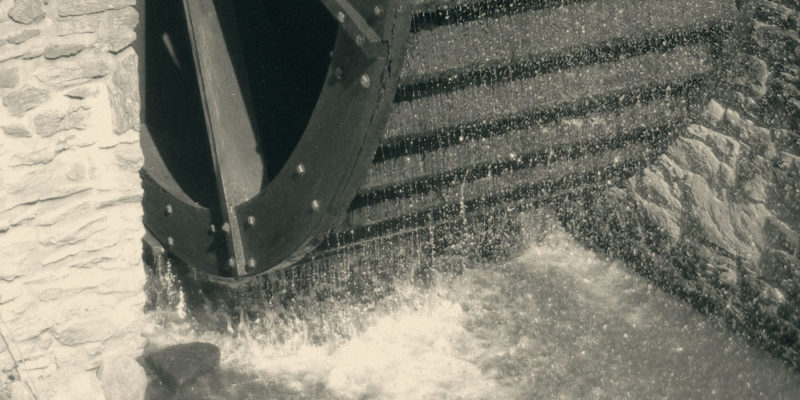Union Mills was among the earliest documented mills in Carroll County based on Oliver Evans’ designs, using the most modern milling technology of the era. The Shriver Grist Mill was located at an ideal location involving a ready source of water and good roads, anchoring a prosperous early industrial complex.
Watch the mill in action in this video produced by The Carroll County Times:
Mill History
On January 25, 1797, Andrew Shriver and his brother, David Shriver, Jr., contracted with John Mong, a Frederick County millwright for $420 to begin supervising and building a set of mills:
“. . . John Mong agrees to build a Sett of Mills . . . with a Mill for Manufacturing grain into flour. To comprehend Two Water Wheels of double geer for Three Pair Grinding and one Pair Shelling Stones. Compleat one Merchent and one Midling Bolt-With Chest Mixers. Packing Rooms, Rolling Screen and Appendages. Hopper Boy and Packing Machine and Compleat one Country Bolt and Chest and one Buckwheat or Corn Bolt and Chest. Two Setts Hoisting Geers, etc. With everything else Needful and Necessary to the above described Work. Also one flutter wheel saw mill with appendages complete. So constructed that the whole workmanlike style calculated to produce the best effect possible agreeable to modern millwrighting.”
Union Mills featured a large, four-story grist mill, built with bricks made on the site, replacing an earlier log mill at the same location. On March 13, 1797 Andrew and David Shriver signed a “Memorandum of Agreement” with Jacob Keefer and John Eckart to “Mould and Burn a Kiln of Brick” for the mill and to provide 100,000 brick or more as would be directed. The Shriver Brothers agreed to pay Keefer and Eckart “at the rate of a French Crown for Every Thousand of Merchentable good sufficient Brick” and to provide their “Board and Lodge”.
Early Industry in Carroll County
Union Mills’ story is that of early industry in the Pipe Creek watershed, along the headwaters of the Monocacy River in the area between Manchester and Detour. In the late eighteenth century, the Pipe Creek Watershed lay in what was then Frederick and Baltimore Counties. Pennsylvania German immigrants were attracted to the area and its network of streams and creeks that provided a strong flow of water for water-powered mills in the wide valleys, and gentle hills that provided fertile land for cutting timber, grazing, farming, and settlement. The Shriver Mill at Union Mills prospered as a merchant mill, with automated milling processes and a reduced need for labor.
Flour Milling in Industrial Growth
Despite Carroll County’s rolling hills and farmland, the area has an important industrial past. Large-scale grain and flour milling was at the heart of growing industrialization of the eighteenth and nineteenth centuries in the area. By 1790, Frederick County (of which Carroll County was then a part) was the largest wheat producer in the United States. Grist mills were built along waterways between Westminster and Frederick, to grind grains into flour. As technology and roads improved, increasing amounts of flour flowed from these mills into Baltimore for export. Between 1815 and 1827, Baltimore was the leading flour market in the United States. The early economic growth of Baltimore and surrounding agrarian areas is linked in large measure to the story of flour milling and improvement in farming, transportation, trade and marketing.
Union Mills Timeline:
1700s
1797: Andrew & David Shriver have mill built by John Mong, for $420.
1800s
1847: Andrew Shriver dies; son William buys mill (deeded 1853).
1848: Wooden water wheels replaced with turbines.
1882: Mill upgraded with roller mills.
1900s
1905: William Shriver’s heirs deed mill to B.F. Shriver Company.
1942: Rear wall collapses & mill ceases operations; metal scrapped to support war effort.
1954: B.F. Shriver Company deeds mill to Klein brothers, who own the Union Mills Homestead.
1964: Kleins form Union Mills Homestead Foundation, Inc. to operate the site.
1973: Klein brothers & the Foundation deed mill to Carroll County for a public historic site.
1970s: Mill stabilized, with new rear wall, new roof, repaired floors.
1982: English engineer and millwright, Derek Ogden, completes the restoration of the flume, waterwheel, and gearing.
2000s
2002: Water wheel, wheel shaft, and apron were reconstructed by millwright Jim Kricker.
2005: The flume was reconstructed using the original design.
TODAY: The Shriver Grist Mill at Union Mills is the last functioning grist mill along Big Pipe Creek, and serves as a historical teaching tool for school groups and locals alike! The mill produces a variety of stone-ground grain products.
// SEE PHOTOS OF THE MILL BEFORE AND DURING RESTORATION
SPOOM Member
Union Mills is a member of the Society for the Preservation Of Old Mills (SPOOM), an international organization dedicated to promoting interest in old mills and other Americana now quickly passing from the present scene. This society helps in the preservation or rebuilding of such structures.

